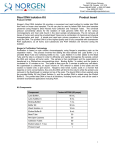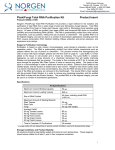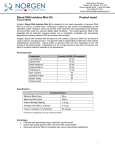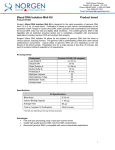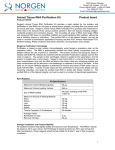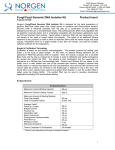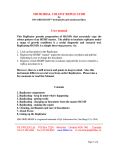Download 26200 - Protocol (50 prep)
Transcript
3430 Schmon Parkway Thorold, ON, Canada L2V 4Y6 Phone: 866-667-4362 (905) 227-8848 Fax: (905) 227-1061 Email: [email protected] Plant/Fungi DNA Isolation Kit Product Insert Product # 26200 Norgen’s Plant/Fungi DNA Isolation Kit provides a rapid method for the isolation and purification of total DNA from a wide range of plant and fungi species. Furthermore, the kit also provides a convenient method for the detection of pathogens which may be infecting a plant, as it allows for the purification of any pathogen DNA along with the purification of the total DNA. Total DNA can be purified from fresh or frozen plant tissues, plant cells or fungi samples using this kit. The DNA is preferentially purified from other cellular components, such as proteins, without the use of phenol or chloroform. The purified DNA is of the highest integrity, and can be used in a number of downstream applications including real time PCR, Southern blotting, SNP analysis and sequencing. Norgen’s Purification Technology Purification is based on spin column chromatography. The DNA is preferentially purified from other cellular components such as proteins without the use of phenol or chloroform. The process involves grinding plant tissue in a mortar with liquid Nitrogen (or alternative homogenization equipment). Lysis Buffer L and RNase A are then added, followed by a short incubation at 65°C. Next, Binding Buffer I is then added to the lysate followed by another short incubation on ice. The lysate is then spun through the provided Filter Column in order to remove any debris. Ethanol is then added to the clarified lysate, and the solution is loaded onto a spin-column. Norgen’s resin binds nucleic acids in a manner that depends on ionic concentrations, thus only the DNA will bind to the column while most of the RNA and proteins are removed in the flowthrough. The bound DNA is then washed with the provided Solution WN and Wash Solution A in order to remove any remaining impurities, and the purified total DNA is eluted with the Elution Buffer B. The purified DNA is of the highest integrity, and can be used in a number of downstream applications. Specifications Kit Specifications Maximum Column Binding Capacity 50 g Maximum Column Loading Volume 650 L Maximum Amount of Starting Material: Plant Tissues Fungi (wet weight) 100 mg 100 mg Average Yields* 50 mg Tomato Leaves 50 mg Grape Leaves 50 mg Peach Leaves 50 mg Plum Leaves 50 mg Pine Needles 100 mg Raspberry Leaves 100 mg Strawberry Leaves Botrytis cinerea (50 mg wet weight) Fusarium sp. (50 mg wet weight) Aspergillus niger (50 mg wet weight) Time to Complete 10 Purifications 18 g 10 g 10 g 10 g 5 g 5 g 2.5 g 1.5 g 2 g 4 g 45 minutes * average yields will vary depending upon a number of factors including species, growth conditions used and developmental stage. 1 Kit Components Component Product # 26200 (50 preps) Lysis Buffer L 30 mL Binding Buffer I 7 mL Solution WN 18 mL Wash Solution A 38 mL Elution Buffer B 15 mL RNAse A 1 vial Filter Columns 50 Spin Columns 50 Collection Tubes 100 Elution tubes (1.7 mL) 50 Product Insert 1 Advantages Fast and easy processing using a rapid spin-column format Adaptable with current cell homogenization methods No phenol or chloroform extractions Isolate high quality total DNA from a variety of plant and fungal species, including any pathogen DNA High yields of total DNA Storage Conditions and Product Stability All solutions should be kept tightly sealed and stored at room temperature, except for the RNAse which should be stored at -20°C. These reagents should remain stable for at least 2 years in their unopened containers. Precautions and Disclaimers This kit is designed for research purposes only. It is not intended for human or diagnostic use. Ensure that a suitable lab coat, disposable gloves and protective goggles are worn when working with chemicals. For more information, please consult the appropriate Material Safety Data Sheets (MSDSs). These are available as convenient PDF files online at www.norgenbiotek.com. Solution WN contains guanidinium salts and should be handled with care. Guanidinium salts forms highly reactive compounds when combined with bleach, thus care must be taken to properly dispose of any of these solutions. Customer-Supplied Reagents and Equipment You must have the following in order to use the Plant/Fungi DNA Isolation Kit: Benchtop microcenrifuge 65°C Incubator Ice bath 96-100 % ethanol 70 % ethanol Liquid nitrogen or any mechanical homogenizer 2 Flow Chart Procedure for Purifying Total DNA using Norgen’s Plant/Fungi DNA Isolation Kit Grind plant or fungi using liquid nitrogen. Add Lysis Buffer L and RNAse A. Incubate at 65°C. Add Binding Buffer I. Incubate on ice. Transfer to Filter Column SPIN Add Ethanol Bind to Spin Column SPIN Wash once with Solution WN Wash twice with Wash Solution A SPIN Elute DNA with Elution Buffer B SPIN Purified Total Plant/Fungi DNA 3 Procedures All centrifugation steps are carried out in a benchtop microcentrifuge. Various speeds are required for different steps, so please check your microcentrifuge specifications to ensure that it is capable of the proper speeds. All centrifugation steps are performed at room temperature. The correct rpm can be calculated using the formula: RPM = RCF (1.118 x 10-5) (r) where RCF = required gravitational acceleration (relative centrifugal force in units of g); r = radius of the rotor in cm; and RPM = the number of revolutions per minute required to achieve the necessary g-force. Notes Prior to Use All centrifugation steps are carried out in a benchtop microcentrifuge at 10,000 x g (~ 10,000 RPM) except where noted. All centrifugation steps are performed at room temperature. A variable speed centrifuge should be used for maximum kit performance. If a variable speed centrifuge is not available a fixed speed centrifuge can be used, however reduced yields may be observed. Ensure that all solutions are at room temperature prior to use. If necessary, warm to 65°C to redissolve precipitates. Prepare a working concentration of Solution WN by adding 24 mL of 96 -100% ethanol (to be provided by the user) to the supplied bottle containing concentrated Solution WN. This will give a final volume of 42 mL. The label on the bottle has a box that can be checked to indicate that ethanol has been added. Prepare a working concentration of the Wash Solution A by adding 90 mL of 96 - 100 % ethanol (provided by the user) to the supplied bottle containing the concentrated Wash Solution A. This will give a final volume of 128 mL. The label on the bottle has a box that may be checked to indicate that the ethanol has been added. Store the RNase A solution at 4°C for up to 3 months. For longer storage, the RNase A solution should be divided into small aliquots and stored at -20 °C. It is recommended that no more than 100 mg of fungi (wet weight) or 100 mg of plant tissue be used for this procedure in order to prevent clogging of the column. However, in some cases it may be possible to increase the amount of plant material processed up to 150 mg depending on the DNA content of the plant. This kit is provided with 2 separate columns. When columns are removed from the labeled bags they are supplied in they can easily be identified as follows: o Filter Columns – contains a clear plastic O-ring o Spin Columns – contains a grey plastic O-ring 1. Lysate preparation a. Place ≤100 mg of plant tissue or wet fungi into a mortar that contains liquid Nitrogen and grind into a powder. Transfer the plant or fungi powder to a DNase-free 1.7 mL microcentrifuge tube (not provided) and add 500 L of Lysis Buffer L and 1 L of RNAse A. Alternatively, other homogenization methods can be used with this procedure, including a bead system. If an alternative method is used, add 500 L of Lysis Buffer L and 1 L of RNAse A to the sample immediately after homogenization and vortex for 20 seconds to mix. 4 b. Incubate at 65ºC for 10 minutes. Occasionally mix the lysate 2 or 3 times during incubation by inverting the tube. c. Add 100 L of Binding Buffer I, mix thoroughly and incubate for 5 minutes on ice. d. Assemble a Filter Column (clear O-ring) with one of the provided collection tubes. Pipette the lysate into Filter Column and spin for 2 minutes at 14,000 x g (~14,000 RPM). e. Transfer only the clear supernatant from the flow-through into a DNAase-free microcentrifuge tube (not provided) using a pipette. f. Add an equal volume of 70% ethanol (provided by the user) to the lysate collected above (100 L of ethanol is added to every 100 L of lysate). Vortex to mix. Proceed to Step 2. 2. Binding to Column a. Assemble a Spin Column (grey O-ring) with one of the provided collection tubes. b. Apply up to 650 L of the clarified lysate with ethanol onto the Spin Column and centrifuge for 1 minute at 10,000 × g (~10,000 RPM). Discard the flowthrough and reassemble the spin column with the collection tube. Note: Ensure the entire lysate volume has passed through into the collection tube by inspecting the column. If the entire lysate volume has not passed, spin for an additional minute. c. Depending on your lysate volume, repeat step 2b if necessary. 3. Column Wash a. Apply 500 L of Solution WN to the column and centrifuge for 1 minute. b. Discard the flowthrough and reassemble the spin column with its collection tube. c. Apply 500 L of Wash Solution A to the column and centrifuge for 1 minute d. Discard the flowthrough and reassemble the spin column with its collection tube. e. Repeat Step 3c and 3d. f. Spin the column for 2 minutes at 14,000 x g (~14,000 RPM) in order to thoroughly dry the resin. Discard the collection tube. 4. DNA Elution a. Place the column into a fresh 1.7 mL Elution tube provided with the kit. b. Add 100 L of Elution Buffer B to the column and incubate for 1 minute at room temperature. c. Centrifuge for 1 minute at 10,000 x g (~10,000 RPM). Note the volume eluted from the column. If the entire volume has not been eluted, spin the column at 14,000 x g (~14,000 RPM) for 1 additional minute. d. (Optional): An additional elution may be performed if desired by repeating steps 4b and 4c using 50 L of Elution Buffer in a different elution tube. The total yield can be improved by an additional 20-30% when this second elution is performed. 5. Storage of DNA The purified genomic DNA can be stored at 2-8°C for a few days. For longer term storage, -20°C is recommended. 5 Troubleshooting Guide Problem Poor DNA Recovery Clogged Column DNA does not perform well in downstream applications Possible Cause Solution and Explanation Column has become clogged Do not exceed the recommended amounts of starting materials. The amount of starting material may need to be decreased if the column shows clogging below the recommended levels. See also “Clogged Column” below. An alternative elution buffer was used It is recommended that the Elution Buffer B supplied with this kit be used for maximum DNA recovery. 70% Ethanol was not added to the lysate Ensure that equal amount of 70% ethanol is added to the lysate before binding to the column. Ethanol was not added to the Wash Solution Ensure the indicated 96 - 100% ethanol amount is added to the supplied Solution WN and Wash Solution A prior to use. Maximum amount of tissue exceeds kit specifications The optimal input is 100 mg of plant tissue or fungi (wet weight). However, for some species, up to 150 mg of tissue may be processed depending on the DNA content of the sample. Too much cell debris in the lysate supernatant Centrifuge the lysate at 14,000 x g (~14,000 RPM) for 5 minutes after step 1c and proceed to Step 1d using the clean supernatant. Centrifuge temperature too low Ensure that the centrifuge remains at room temperature throughout the procedure. Temperatures below 20°C may cause precipitates to form that can cause the columns to clog. PCR reaction condition is needed to be optimized Take steps to optimize the PCR conditions being used, including varying the amount of DNA template, changing the source of Taq polymerase, looking into the primer design and adjusting the annealing condition. Binding Buffer I was not added to the lysate Ensure that the Binding Buffer I is added to the lysate and that it is incubated on ice for 5 minutes prior to spinning down the lysate DNA was not washed with the provided Wash Solution A Traces of salt from the binding step may remain in the sample if the column is not washed twice with the Wash Solution A. Salt may interfere with downstream applications, and thus must be washed from the column. Ethanol carryover Ensure that the dry spin under the Column Wash procedure is performed, in order to remove traces of ethanol prior to elution. Ethanol is known to interfere with many downstream applications. 6 Related Products Plant/Fungi DNA Isolation Kit Plant RNA/DNA Purification Kit Plant/Fungi Total RNA Purification Kit Direct Fungi DNA Isolation Kit HighRanger 1kb DNA Ladder Product # 26200 24400 25800 25600 11900 Technical Support Contact our Technical Support Team between the hours of 8:30 and 5:30 (Eastern Standard Time) at (905) 227-8848 or Toll Free at 1-866-667-4362. Technical support can also be obtained from our website (www.norgenbiotek.com) or through email at [email protected]. 3430 Schmon Parkway, Thorold, ON Canada L2V 4Y6 Phone: (905) 227-8848 Fax: (905) 227-1061 Toll Free in North America: 1-866-667-4362 © 2015 Norgen Biotek Corp. PI26200-14-M14 7







